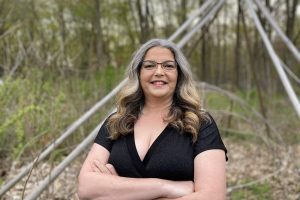Incorporating Indigenous Knowledges into Academia
September 26/2023
Two common threads are woven through Dr. Angela Mashford-Pringle’s prolific 2023 public health research output: the importance of recognizing that Indigenous knowledges are as valid and as crucial as Western perspectives and the need to consult Indigenous peoples when conducting health research. She is committed to ensuring that Western institutions value the input their Indigenous colleagues provide.
By Elaine Smith
“There’s nothing to say randomized trials are more effective than our observational research,” says Mashford-Pringle, Associate Director of the Waakebiness Institute for Indigenous Health, an Assistant Professor in the Social and Behavioural Health Sciences (SBHS) Division in DLSPH and the Indigenous Health Lead for DLSPH. “But Indigenous people still aren’t being consulted. Nothing has changed since 1979. We’re not seen yet. We’re heard, but they [those in power] are still not inviting us to the table. We’re telling the Western paradigm that this is the way we need to go.”
Her mention of 1979 refers to the year the Canadian government instituted the Indian Health Policy. In the paper, “Appraising Canada’s 1979 Indian Health Policy,” Mashford-Pringle and IHPME alumna Denise Webb assess the federal policy, identify gaps and evaluate its impact, providing recommendations to “inform the federal government’s efforts to co-develop distinctions-based Indigenous health legislation.”
When it comes to health-care research, Mashford-Pringle makes a strong case for viewing Indigenous people as distinct from their Western counterparts in addressing their health-care needs. In the paper, “Needing indigenous biometrics for health in Canada,” she and her co-authors undertake a critical analysis of biometric use in clinical practice. They find that rather than being objective measures, noting “This standard is often based on white populations of European descent… The comparison contributes to colonial and racist notions of inadequacy and deficit focuses among First Nations, Inuit and Métis populations compared to non-Indigenous populations.”

Angela Mashford Pringle, Associate Director of the Waakebiness Institute for Indigenous Health
Mashford-Pringle is also a strong advocate for Indigenous knowledges.
“When I was a PhD student at DLSPH, I was told there was no Indigenous theory, that it did not exist, so I’m trying for future generations and Indigenous PhD students, in particular, to start legitimizing our theories,” Mashford-Pringle says.
Her paper, “Using the Medicine Wheel as theory, conceptual framework, analysis, and evaluation tool in health research,” demonstrates the utility and validity of the Indigenous perspective. Co-authored with Dr. Amy Shawanda, an Assistant Professor at McGill University, the paper discusses the use of the medicine wheel as both conceptual framework and theory among many North American Indigenous communities. The medicine wheel is divided into four quadrants representing human life: self, family, community and nation. All four quadrants, each equally important, must be as balanced as possible for someone to achieve health and well-being. The paper demonstrates that employing a non-linear view can add to the user’s understanding.
“It is possible to expand our abilities to see patterns, themes, connections, and wholism by looking beyond linear positivistic methods through many ways to use Medicine Wheel teachings,” the authors write.
In research that also highlights Indigenous perspectives, Mashford-Pringle discusses Indigenous architecture as a way of promoting wellbeing in a paper entitled, “Mamwi Gidaanjitoomin/Together We Build It.”
“In modern, western society, dominated by scientific rationalism and capitalism, mainstream architecture has gradually lost its connection to place,” write Mashford-Pringle and her co-authors. “Whether we can foster a good relationship between humans and the environment is directly linked to how and where we design and construct our home structures… Indigenous traditional architecture is a great manifestation of Indigenous holistic ways of thinking and being… rooted in all relations being interconnected and interdependent, can provide valuable insights on how humans can rebuild the connection between people, environment, and architecture, which in turn promotes the well-being of all.”
In addition to using research as a tool for disseminating and legitimizing Indigenous perspectives in western academia, Mashford-Pringle has also developed the New Respect Indigenous Cultural Safety program with Dr. Debby Danard, DLSPH Post-Doctoral Fellow, and the AMP Lab team. The pilot of the program was provided to DLSPH, Factor-Inwentash Faculty of Social Work, Temerty Faculty of Medicine, and Lawrence S. Bloomberg Faculty of Nursing at the University of Toronto in early 2023. The online content provided participants with the opportunity to hear from Indigenous community members and Elders about their experiences in healthcare, social services, and education with a profession-specific module to assist with their chosen field.
This dedication to cultural safety is a foundational component of her research and as seen in the PRISMA scoping review “Indigenous Cultural Safety Training for Applied Health, Social Work, and Education Professionals.” As the senior author on the paper, she provides a broad synthesis of the academic literature on cultural safety training programs that are developed, implemented, and evaluated in the applied health, social work and education fields in Canada, the United States, Australia and New Zealand. The preliminary results of the pilot program are being drafted.
As Sterling Stutz, a SBHS PhD student and Research Officer of the AMP Lab at Waakebiness who has published with Mashford-Pringle, notes, “Some of what we’re doing in this work is making visible the disruptions that colonialism has caused… The solutions are not going to be within the colonial system. The solution is allowing the space to let Indigenous knowledge work.”